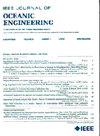从北冰洋 C 波段哨兵-1 图像中检索海面波浪
IF 5.3
2区 工程技术
Q1 ENGINEERING, CIVIL
引用次数: 0
摘要
由于海冰反射引起的失真,在北冰洋地区使用c波段合成孔径雷达(SAR)估算海面波场面临着巨大的挑战。本文介绍了一种新的方法,成功地考虑了海冰在纬度SAR波检索中的影响,采用k均值聚类算法从图像中估计海冰浓度。利用训练数据集中的1000幅图像,生成不同海冰浓度条件下VV和HH极化下的倾斜映射模型传递函数(mtf)。然后,对另外600幅北冰洋测试数据集的波浪检索图像,采用更新后的倾斜MTF,实现了一种理论波浪检索算法,即参数化首猜谱法。对sar衍生的SWHs和WW3模拟进行压缩,使用更新的倾斜MTF得到的RMSE为0.45 m, COR为0.91,偏差为0.38 m, SI为0.11,这是使用先前倾斜MTF获得的RMSE 0.60 m,偏差为0.41 m, COR为0.88,SI为0.14的改进。此外,基于对HY-2B高度计测量值的sar衍生SWH的验证,利用更新的倾斜MTF, vv极化sar衍生SWH的精度提高了约0.15 m的RMSE和0.08 m的偏差。然而,检索中的噪声仍需要进一步降低。本文章由计算机程序翻译,如有差异,请以英文原文为准。
Sea Surface Wave Retrieval From C-Band Sentinel-1 Images in the Arctic Ocean
The Arctic Ocean presents significant challenges for estimating sea surface wave fields using C-band synthetic aperture radar (SAR) due to the distortion caused by the reflection of sea ice. This article introduces a novel procedure to successfully consider the influence of sea ice in SAR wave retrieval at latitude <80°.>K-means clustering algorithm was applied to estimate sea ice concentration from the images. Using 1000 images in the training data set, the tilt mapping model transfer functions (MTFs) in VV and HH polarization are generated under various sea ice concentration conditions. Then, a theoretical wave retrieval algorithm, namely, the parameterized first-guess spectrum method, that uses the updated tilt MTF was implemented for an additional 600 images in a test data set for wave retrieval in the Arctic Ocean. Compression of the SAR-derived SWHs and WW3 simulations yields an RMSE of 0.45 m, a COR of 0.91, a bias of 0.38 m, and an SI of 0.11 using the updated tilt MTF, which is an improvement upon the RMSE of 0.60 m, a bias of 0.41 m, a COR of 0.88, and an SI of 0.14 obtained using the previous tilt MTF. Moreover, the accuracy of VV-polarized SAR-derived SWH by using the updated tilt MTF is improved by approximately 0.15-m RMSE and 0.08-m bias, which is based on validating SAR-derived SWHs against the measurements from the HY-2B altimeter. However, the noise in the retrievals still needs further mitigation.
求助全文
通过发布文献求助,成功后即可免费获取论文全文。
去求助
来源期刊

IEEE Journal of Oceanic Engineering
工程技术-工程:大洋
CiteScore
9.60
自引率
12.20%
发文量
86
审稿时长
12 months
期刊介绍:
The IEEE Journal of Oceanic Engineering (ISSN 0364-9059) is the online-only quarterly publication of the IEEE Oceanic Engineering Society (IEEE OES). The scope of the Journal is the field of interest of the IEEE OES, which encompasses all aspects of science, engineering, and technology that address research, development, and operations pertaining to all bodies of water. This includes the creation of new capabilities and technologies from concept design through prototypes, testing, and operational systems to sense, explore, understand, develop, use, and responsibly manage natural resources.
 求助内容:
求助内容: 应助结果提醒方式:
应助结果提醒方式:


